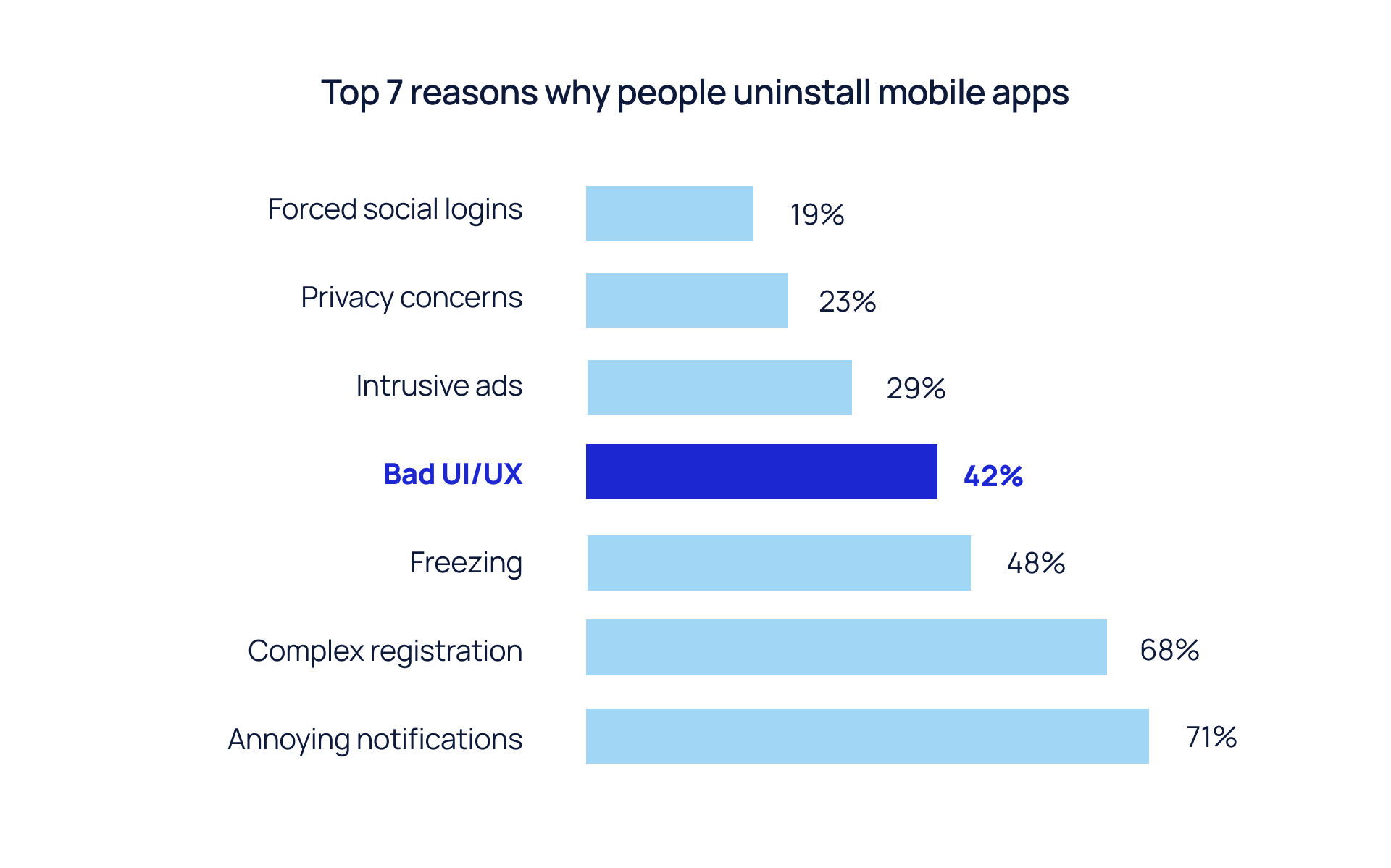How to avoid medical app development failures

Given the fierce competition, it is fairly difficult to hang on to the digital medical market. How to develop a product destined for success?
How to avoid failures when developing medical applications
Health-oriented apps have a positive impact on people's health outcomes and reduce disparities in access to care [1].
The number of medical applications continues to rise each year. Indeed, the market for medical apps is growing at 23% quarter-over-quarter, while the market growth for health-oriented and fitness apps is equal to 20% quarter-over-quarter, according to Data.ai [2]. At this rate, the global mHealth applications market is expected to grow at a compound annual growth rate (CAGR) of 11.8% from 2022 to 2030 [3].
Considering that the mobile app market is unlikely to slow down, the competition will become even more intense. It does hurt to see your brainchild perish in the fiercely competitive mobile app market where even a powerful and versatile application does not guarantee a breakthrough. Nevertheless, although mistakes in development are bound to happen, you can try to minimize them and be prepared in case of unforeseen circumstances.
To prevent your future product from failing, learn from most significant failures. That way, you are more likely to keep your business from wasting money.
How to avoid failures or how to release a future-proof product?
Start with a meticulous research
The most important rule at the beginning of mobile app development is to allocate enough time to the pre-development stage. The bottom line is that startup owners are often obsessed with ideas, wanting to start implementing them as soon as possible. Consequently, due to the prioritization of the product release and all its miscellaneous features, the need for meticulous research and analysis is commonly put on the back burner.
Even the giant Google has unsuccessful cases - or "killed by Google" [4]. Most of the projects simply did not find their user and/or turned out to be unpromising. Of course, you do not need to be a psychic to predict the market situation in 5-10 years, but data-driven analysis is still a powerful thing.
Here are a couple of tips at this point:
- Find the user's very pain points and priority needs.
- Analyze the market, competitors, and potential prospects.
- Validate your future product idea and evaluate the possible "ifs," followed by the "thens...".
Application design is not a priority? This could be the reason for the failure
For example, there is a secure medical app backed by powerful data protection and compliance on one side, and an app with an attractive design on the other. Which would you choose? The answer is likely to be in favor of the former. However, the lack of proper UX and UI can backfire on you in the onboarding process, let alone the subsequent app usage.
Poor UI/UX is fourth on the list of reasons why users refuse to download the app or use it in the future [5].

We recommend that you pay attention to the UI/UX application if:
- The app takes too long to load. Today's users don't tolerate downtime. By keeping them waiting, you risk losing them. Getting them back will be very difficult.
- It lacks creativity and personality. Users assess an app first and foremost with their eyes, so a "devoid of visual zest" app is unlikely to draw their attention.
- The app is poorly navigated. If the user has to scroll and click repeatedly to find what he or she needs, annoyance will not be long in coming.
Don't overload the product with useless features
"The more features, the more likely it is that each one will find its user". That may make sense, but you are likely to end up with a feature-rich product in which users can easily get lost. They just might not get to the one that would help them meet their current needs. Designing an application for everyone is not a good tactic. In addition, practice shows that the user uses only a couple of functions, overlooking the rest [6].
What’s more, these unnecessary functions need to be monitored and updated so as not to damage the functionality of the application itself. It turns out that you can spend more resources where you could have avoided it.
Yes, marketing is also essential
"Marketing is not relevant in such a serious field as healthcare." This is one of the common healthcare marketing myths that prevent startups from releasing a product with the maximum target audience reach.
Moreover, even if the product is technically and design-perfect, the lack of marketing strategies before and after launch will leave it in the shadows. This is the worst thing you can expect after countless hours spent on perfecting the final solution.
Accurate testing can help troubleshoot bugs timely
Application testing takes place throughout its development, allowing it to detect and eliminate bugs both in the technical part of the application and in its design. Also, it is highly recommended to perform user testing after the MVP creation, as this enables you to assess the degree of the application's relevance from the user's point of view.
Medical application testing: what does it involve?
- Preparing a test plan to help the team estimate the duration of the process, measure the resources required and analyze outcomes.
- Engaging QA engineers to analyze requirements and assess risks.
- Functional testing to confirm the smooth solution operation.
- Non-functional testing to estimate performance, reliability, and security.
- UI & UX testing.
- Regression testing to make sure that changes in the code have not compromised the app's functionality.
- Documentation of all modifications to make a final decision on whether the product is release-ready.
Choose a medical-focused team
Even a minor bug in a digital medical solution can have dire consequences: it can cost a human life. A regular software house may not know the ins and outs of designing such applications, which can lead to the aforementioned outcome.
It's critical to find niche specialists since:
- They have extensive medical experience, which is crucial when developing a healthcare app.
- Hiring a development company with medical expertise can result in a more prosperous project.
- Such companies know all the pitfalls, including the necessary regulations and how to protect data confidentiality.
The product can be created either by a regular development company or a med-oriented software house. However, considering all the intricacies and challenges associated with healthcare, the outcomes will be much better if the task falls into the hands of those who know this sector from the inside out.
Brandmed will help you turn your idea into a ready-to-use and future-proof product. With more than 7 years of experience, our fully staffed team with medical know-how is aware of all the intricacies of digital medicine. Contact us, and we'll discuss the details.
References:
- Annual Reviews, A Review of the Quality and Impact of Mobile Health Apps, https://www.annualreviews.org/doi/full/10.1146/annurev-publhealth-052020-103738, [last accessed: 14.12.2022].
- Forbes, Top Apps Of 2022 By Installs, Spend, And Active Users: Report, https://www.forbes.com/sites/johnkoetsier/2022/03/23/top-apps-of-2022-by-installs-spend-and-active-users-report/?sh=480a30d3d3ac, [last accessed: 14.12.2022].
- Grand View Research, mHealth Apps Market Size, https://www.grandviewresearch.com/industry-analysis/mhealth-app-market, [last accessed: 14.12.2022].
- Killed by Google, Killed by Google, https://killedbygoogle.com/, [last accessed: 14.12.2022].
- Decode, 14 Mistakes to avoid when developing your app, https://decode.agency/article/app-development-mistakes/, [last accessed: 14.12.2022].
- Good reads, The Inmates Are Running the Asylum: Why High Tech Products Drive Us Crazy and How to Restore the Sanity by Alan Cooper, https://www.goodreads.com/book/show/44098.The_Inmates_Are_Running_the_Asylum, [last accessed: 14.12.2022].
 Medical Content Creation
Medical Content Creation
 Digital Product Development
Digital Product Development
 Growth Marketing
Growth Marketing
